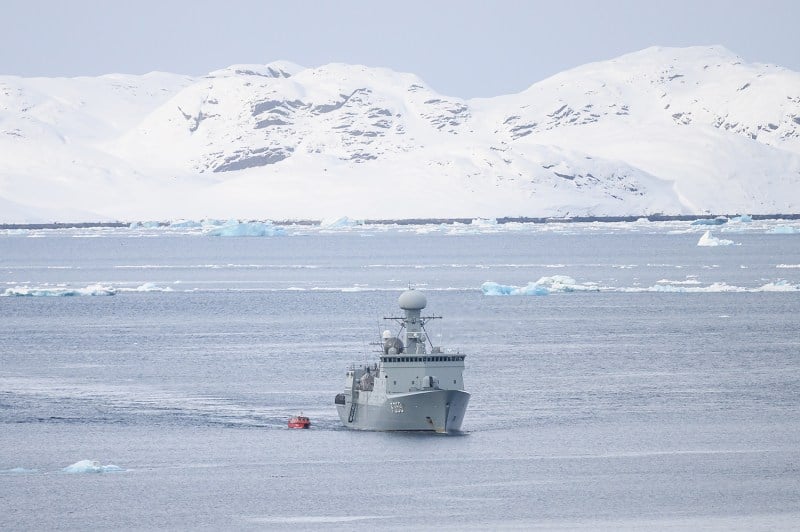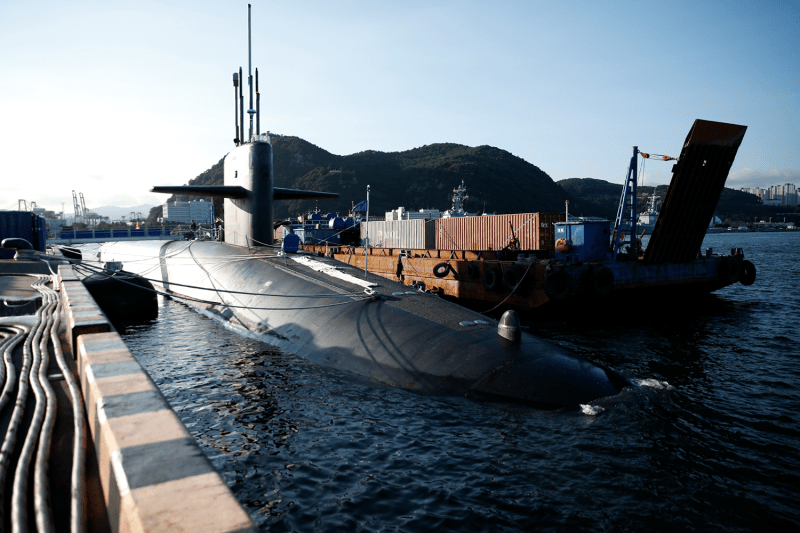Trump’s Greenland Obsession Will Not Secure America

Trump’s Greenland Obsession Will Not Secure America
Countering Russia and China in the Arctic requires leveraging alliances, not fracturing them.
A Danish Navy ship patrols the bay in Nuuk, Greenland, on March 27. Leon Neal/Getty Images
One of U.S. President Donald Trump’s most frequent fixations during his first 100 days in office has been his desire to “get Greenland.” When rationalizing this radical impulse, the president and his aides have cited a need to “counterbalance” growing collaboration in the Arctic between the United States’ most consequential adversaries—Russia and China.
“You have Russian ships all over the place. You have Chinese ships all over the place. They are sailing all over Canada, they are sailing right next to Greenland. We’re not going to let that happen,” Trump said in an interview. He is right that expanding Beijing-Moscow cooperation in the High North challenges U.S. national security. But checking this emerging threat to the Western Hemisphere requires Washington to cooperate with its Arctic allies, not alienate or annex them. Policymakers and strategists should focus American attention and resources on the United States’ position in Alaska, particularly near the Bering Strait, which is the chokepoint for Chinese access to the Arctic Ocean.
One of U.S. President Donald Trump’s most frequent fixations during his first 100 days in office has been his desire to “get Greenland.” When rationalizing this radical impulse, the president and his aides have cited a need to “counterbalance” growing collaboration in the Arctic between the United States’ most consequential adversaries—Russia and China.
“You have Russian ships all over the place. You have Chinese ships all over the place. They are sailing all over Canada, they are sailing right next to Greenland. We’re not going to let that happen,” Trump said in an interview. He is right that expanding Beijing-Moscow cooperation in the High North challenges U.S. national security. But checking this emerging threat to the Western Hemisphere requires Washington to cooperate with its Arctic allies, not alienate or annex them. Policymakers and strategists should focus American attention and resources on the United States’ position in Alaska, particularly near the Bering Strait, which is the chokepoint for Chinese access to the Arctic Ocean.
Cooperation between Russian President Vladimir Putin and Chinese President Xi Jinping in the Arctic is intensifying as melting sea ice creates new opportunities to exploit and transport its abundant natural resources and affords easier access to polar space orbits for satellite launches. In expanding their “no limits” partnership into high latitudes, the two Eurasian giants benefit from divisions in the NATO alliance, which has been an effective bulwark in the region since the Cold War. These relationships must be reinforced to prevent Russia from further consolidating its dominant position along much of the strategic Arctic waterway and to limit China’s expanding capabilities across the theater.
But Sino-Russian Arctic cooperation is not inevitable or permanent. Indeed, until its full-scale invasion of Ukraine, Russia sought to limit China, a self-declared “near-Arctic state,” from extending its superior military-industrial capability and scale into the Arctic. The Kremlin’s protective instincts were broadly shared by the United States and other countries bordering the Arctic Ocean. This rare point of accord came from mutual wariness of China, the only rising great power and the only new player with major ambitions in the region. For a time, Russia even worked constructively within the Arctic Council to help keep China in check—until Moscow was expelled from the multilateral body for its aggression against Ukraine.
Russia’s balanced strategy is gone now. Under Putin’s direction, the reeling Russian economy is growing more dependent on Chinese industrial, technological, and financial power. Chinese companies have come to the rescue of Russian Arctic energy projects abandoned by the West and become the biggest importer of Russian crude oil—which increasingly flows eastward on newly built Chinese ice-class ships sailing home through Russian waters and no longer westward into Europe. Beijing is taking advantage of Moscow’s isolation to gain more opportunities to exploit Russia’s extensive Arctic coastline, absorb its energy and mineral resources, develop its polar science and technological capabilities, and expand its military reach.
Moscow may still resent its giant neighbor’s aims to encroach on its strategic backyard and raid its Arctic resources, but it will find it increasingly hard to say no to Beijing. Though the Chinese economic and strategic presence in the Arctic is still in its infancy, it will continue to grow. In recent months, China and Russia have intensified their combined operations, flying strategic bomber runs off Alaska, exercising naval and coast guard forces in and around the Bering Sea, and conducting marine research across the Arctic that serves both military and scientific purposes. Meanwhile, U.S. capability and awareness in the Arctic have atrophied to an alarming degree.
Balancing the expansion of Chinese and Russian power in the Arctic theater is a tall order for an overstretched U.S. military. After the Cold War, Washington drew down its Arctic presence by closing bases, curtailing military operations, and neglecting aging infrastructure. The U.S. Coast Guard presently struggles to maintain even one heavy icebreaker to enable surface operations in Arctic waters. China, meanwhile, fields three and counting, whereas Russia employs an astonishing 40—including the world’s only nuclear-powered vessels in this class.
After a long post-Cold War hiatus, the United States began to revive its ancient early warning radar and overmatched ballistic missile defenses, and it has gradually increased air and naval activity. In 2021, the United States and Canada agreed to modernize their joint North American Aerospace Defense Command (NORAD) to better detect and deter the mounting threat from advanced Chinese and Russian missiles. The Trump administration appears committed to continuing in this vein, but Trump’s Greenland fixation undermines and misdirects these efforts.
China’s only direct Arctic access runs through the narrow Bering Strait between Alaska and the Russian Far East, a continent away from Greenland. Russia is still holding China’s military at arm’s length on the European side of the Arctic, denying its warships, submarines, and aircraft the permissions and infrastructure they need to access the region. But should Moscow one day succumb to Beijing’s steady pressure to operate further west, the United States will need its Arctic allies to continue holding the line and sharing the burden.
The Artic states, all NATO members save Russia, are already treaty-bound and demonstrably willing to allow U.S. military access, basing, and overflight. During the Cold War, Greenland hosted as many as 17 U.S. military installations with 12,000 soldiers. Even when a U.S. Air Force B-52 bomber crashed near one of those bases in 1968, rupturing its nuclear payload and dispersing radiation into Greenland’s waters, Denmark still quietly permitted the United States to deploy nuclear weapons from its strategic island territory to counter the Soviet threat.
These staunch allies continue to complement and enhance U.S. posture in the region. Nordic states already excel in polar navigation, special operations, and surveillance, and many build exquisite naval and commercial ships, including submarines, icebreakers, and survey ships. Finland’s icebreaker capacity is of special importance, given persistent U.S. challenges in building and deploying these complex vessels that are essential to operating in the demanding Arctic environment.
Throughout the Cold War, NATO successfully bottled up Soviet forces by protecting the Greenland-Iceland-United Kingdom (GIUK) gap. During Trump’s first term, Denmark honored U.S. requests to reject or revoke China’s bids to establish critical infrastructure and mining operations in Greenland. Despite Washington’s newly aggressive stance, Copenhagen and Ottawa still signal their interest in continuing a successful long-term partnership with Washington to address shared threats to their sovereignty and security.
If Trump actually wants to defend the Western Hemisphere from China and Russia, his focus on acquiring Greenland is strategically unsound. Whatever becomes of NATO, to date it has been extraordinarily effective at protecting the United States’ northern approaches from Soviet and now Chinese and Russian advances. The United States’ advantage lies, as ever, not only in its geographic distance from its rivals, but also in this unparalleled network of allies. Any competitive strategy will need to leverage the alliance system by beefing it up. Threatening allies and letting Beijing and Moscow play on Western divisions will only weaken U.S. security.
This post is part of FP’s ongoing coverage of the Trump administration. Follow along here.
Isaac B. Kardon is a senior fellow for China studies at the Carnegie Endowment for International Peace.
Alexander Gabuev is a senior fellow at the Carnegie Moscow Center. X: @AlexGabuev
Stories Readers Liked
In Case You Missed It
A selection of paywall-free articles

Four Explanatory Models for Trump’s Chaos
It’s clear that the second Trump administration is aiming for change—not inertia—in U.S. foreign policy.























Join the Conversation
Commenting is a benefit of a Foreign Policy subscription.
Subscribe
Subscribe
Already a subscriber?
.
View Comments
Join the Conversation
Join the conversation on this and other recent Foreign Policy articles when you subscribe now.
Subscribe
Subscribe
Not your account?
View Comments
Join the Conversation
Please follow our comment guidelines, stay on topic, and be civil, courteous, and respectful of others’ beliefs.
View Comments
Change your username |
Log out
Change your username:
CANCEL
Confirm your username to get started.
The default username below has been generated using the first name and last initial on your FP subscriber account. Usernames may be updated at any time and must not contain inappropriate or offensive language.